|
The secret of the Roper River's constant flow lies in vast basins
of water under the ground.
This massive limestone formation extends north of Katherine and to the Queensland
border.
Although outcrops of the rock can be seen along the highway between Mataranka
and north of Katherine, most of the limestone is below ground.
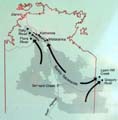
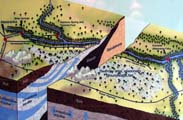
Where the land surface has been worn away and cuts the underground
water level, water flows out of the ground as springs.
The water of the Bitter Springs and Rainbow Springs has travelled
underground from the Barkly Tablelands to surface around Mataranka
before it flows down the Roper River into the Gulf of Carpentaria.
Bitter Springs and Rainbow Springs lie along fractures on the
edge of a limestone aquifer that extends through a large part of
the Northern Territory.
The aquifer is porous. The soluble limestone is scaled underneath
by a layer ofimpermeable basalt.
Where limestone is the surface rock
in this area the ground gets swampy during the wet season when
rain recharges the aquifer.
The climate here consists of a short wet season followed by a
long dry season.
From November to April wet season rains saturate and then flood the land, but
it seldom rains between May and September.
During the wet season, surface water also adds to the flow of
the recharged aquifer and the Roper River.
On average, the flow from Bitter Springs is about 300 litres per
second and Rainbow Springs is about 130 litres per second.
Huge reservoirs of water, 30 to 100 metres underground, are heated
to the temperature of the ground at this depth, around 34°C,
before being released as crystal clear spring water.
The springs
in Elsey National Park are not true hot springs in that there is
no underground "hot spot" heating the water, just
the normal temperature increase with depth.
Bitter Springs
Bitter Springs was named by a Steven King, a worker on the Overland
Telegraph Line in 1871, for the bitter taste of the water.
John Anderson Gilruth thought the name might put people off this
land that he hoped to make a major agricultural centre, so he renamed
the area Mataranka.
The springs were an attraction for early European settlers in the
area.
In 1902 Jeannie Gunn described them in her book "We
of the Never Never":
"A chain of clear crystal pools with emerald-green mossy banks and everywhere
sunflecked, warm, dry shade."
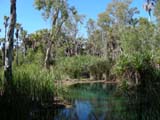
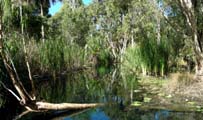
At Bitter Springs you can see how life adapts to this wet-dry cycle.
Above
the water, tall palms and paperbarks tolerate bursts of flooding,
extended periods of water logging and a slow drying.
Under the water's
surface life struggles with raging currents in the wet season and
warm, nutrient-rich water that is low in oxygen through the dry
season.
Debris stacked high and low in and around the trees left by wet
season flooding act as wildlife shelters through the dry season.
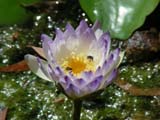
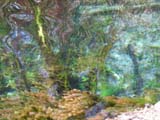
The nutrient
rich springs support plenty of algae, which drifts to the surface
and collects in rotting mats where insects thrive and become food
for birds, lizards and other small animals.
Sunlight shining through
clear, nutrient-rich, warm water provides perfect conditions for
plants and algae to grow.
During the dry season all of the water here comes from underground
and is laden with dissolved limestone minerals.
As sunlight is
added to this solution plants and algae thrive, driving a cycle
of growth and decomposition.
Through the dry season bits of decomposed plants and algae float
to the surface and drift to the edges, clumping in mats.
These
stinking, rotten mats connect the food cycle above the water with
the aquatic food cycle until wet season rains flush the system
and change these food cycles.
Under the water bacteria are breaking down the alga (green slime)
that grows so well in these nutrient rich waters.
This decomposition
process uses much of the oxygen created by plants in the water.
Adding to the smell in this swampy low oxygen environment are
certain bacteria that use the oxygen from the sulphate mineral
in the groundwater.
A by-product of this is hydrogen sulphide,
also known egg gas because of its smell of rotten eggs.
Fish do not seem to do so well, probably because there is not
a lot of oxygen.
The Mataranka Hot Springs
At Mataranka's Rainbow Springs 30.5 million litres of spring
water per day flows through the pool, out into the Waterhouse River
and on into the Roper River.
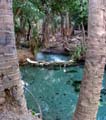
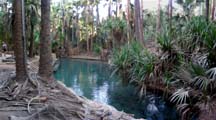
These springs were a favorite swimming spot for early
pastoralists and for navvies working on the railway from Darwin
to Mataranka in 1928.
During World War II, soldiers stationed around Mataranka decided
to enlarge the narrow channel from the spring to the Waterhouse
River.
The pool they built was for use by officers only.
After the war one of these soldiers leased Mataranka Homestead and opened
up the thermal pool to tourists.
In 1975 the springs and surrounding land became a nature reserve and recently
part of Elsey National Park.
The Little Red Flying-Fox and the Cabbage Palms
Along the way to the Mataranka's Rainbow Springs high cabbage
palms grow.
Botanists who have recently re-examined this palm (Livistonia mariae ssp. ridgida)
now regarded it as a sub-species of the red cabbage palm of Central Australia.
That palm only grows in small pockets along Palm Valley and the Finke River
west of Alice Springs which is over 1 000 kilometres south-west from Mataranka!
This wide but isolated distribution hints that Australia was once a much wetter
and tropical place.
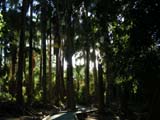
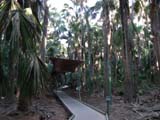
Furry Little Red Flying-Foxes live in these palms.
Because of their droppings the walkway to the springs had to be covered ....
Little Red is born, eyes open and weighing about 80 grams.
He attaches to one of mum's nipples (there is one under each wing pit) and
Little Red is wrapped in her wings.
For the next month or so the pup will hang on with mouth and claws when mum
flies out to feed.
When he gets too heavy, she will leave Little Red in a nursery with other pups.
After about a month of practice flights, Little Red is three months
old and ready to fly out for a feed.
An excellent sense of smell and good eyesight make it easy for Little Red Flying-foxes
to find their favourite white Eucalyptus, Corymbia and Melaleuca blossoms at
night.
Little Red Flying-foxes follow flowering trees further inland than other flying-foxes.
Most feeding is within 15 km of camp, but Little Red will travel
up to 50 km (100 km return) to find food.
Some trees produce most of their nectar and pollen at night to coincide with
when flying-foxes are feeding.
Fruit is chewed and spat out while juices and small seeds are
swallowed.
Seeds are flown to new areas before being deposited in flying-fox poo.
Flying-foxes can dispense up to 60 000 seeds in one night.
When feeding on flowers, pollen, a good source of protein, gets
stuck on the fur and is licked off.
Flying-foxes pick up and carry dustings of pollen from tree to tree pollinate
flowers as they feed.
Woodland trees rely heavily on this for crosspollination, especially over the
longer distances not covered by insects and small birds.
At times there have been up to 250 000 flying-foxes in Mataranka
resulting in an overwhelming smell .....
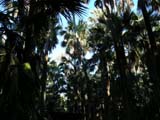
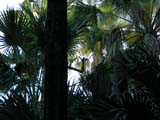
With that many animals the palms got crowded.
This caused damage to them and sometimes even destroyed them.
For
this reason the palms in Mataranka have been equipped with sprinklers.
Spraying water in to the tops of the palms prevents too many of
the Little Reds living on them.
| 










